Stepwise Building Damage Estimation Through Time-Scaled Multi-Sensor Integration: A Case Study of the 2024 Noto Peninsula Earthquake
Abstract
1. Introduction
2. Materials and Methods
2.1. Overall Methodological Workflow
2.2. The 2024 Noto Peninsula Earthquake and Study Area
2.3. Building Damage-Related Data
2.3.1. Real-Time Earthquake Building Damage Estimation Data
2.3.2. ALOS-2 Radar Satellite-Derived Building Damage Estimation Data
2.3.3. Damage Report Issued by the Ishikawa Prefectural Government
2.3.4. Social Networking Service Information
2.4. Data Processing and Validation
2.4.1. Estimation of Building Exposure
2.4.2. REBDE-Based Building Damage Estimation
2.4.3. ALOS-2-Based Building Damage Estimation
2.4.4. Integrated Building Damage Estimation
2.4.5. Validation of Estimation and Observation Datasets
2.5. Field Investigation of Damaged Areas
3. Results
3.1. Official Building Damage Count
3.2. Comparison of Real-Time, Satellite Observation-Based, and Integrated-BDE Results
3.3. Comparison of Simulation-Based, Satellite-Derived, and Integrated-BDE Results
3.4. Spatiotemporal Summarization of Earthquake-Induced Building Damage-Related Social Media Data
3.5. Proposed Stepwise Estimation of Building Damage Framework Using Time-Scaled Multi-Sensor Integration
4. Discussion and Limitations
4.1. Stepwise Estimation of Building Damage Using Time-Scaled Multi-Sensor Integration
4.2. Utilization of Stepwise BDE Approach
4.3. Limitations
5. Conclusions
Author Contributions
Funding
Institutional Review Board Statement
Informed Consent Statement
Data Availability Statement
Acknowledgments
Conflicts of Interest
References
- Ministry of Land, Infrastructure, Transport and Tourism. White Paper on Land, Infrastructure, Transport and Tourism in Japan; MLIT: Tokyo, Japan, 2011. [Google Scholar]
- Japan Broadcasting Corporation. Death by Crushing, Hypothermia, and Freezing. Available online: https://www3.nhk.or.jp/news/html/20240131/k10014341451000.html (accessed on 20 June 2025).
- National Research Institute for Earth Science and Disaster Resilience. About NIED. Available online: https://www.bosai.go.jp/e/about/ (accessed on 20 June 2025).
- Kinoshita, S. Kyoshin Net (K-NET). Seismol. Res. Lett. 1998, 69, 309–332. [Google Scholar] [CrossRef]
- Aoi, S.; Obara, K.; Hori, S.; Kasahara, K.; Okada, Y. New strong-motion observation network: KiK-net. EOS 2000, 81, F863. [Google Scholar]
- Fujiwara, H.; Nakamura, H.; Takahashi, I.; Senna, S.; Wakai, A.; Naito, S.; Morikawa, N.; Maeda, T.; Azuma, H.; Iwaki, A.; et al. Development of Real-time System for Earthquake Damage Information in Japan (J-RISQ); National Research Institute for Earth Science and Disaster Prevention (NIED): Tsukuba, Japan, 2019. [Google Scholar]
- Fujiwara, H.; Nakamura, H.; Senna, S.; Otani, H.; Tomii, N.; Ohtake, K.; Mori, T.; Kataoka, S. Development of a Real-Time Damage Estimation System. J. Disaster Res. 2019, 14, 315–332. [Google Scholar] [CrossRef]
- Japan Real-time Information System for earthQuake. Earthquake Early Warning. Available online: https://www.j-risq.bosai.go.jp/report/ (accessed on 20 June 2025).
- The Japan Building Disaster Prevention Association. Postearthquake Quick Inspection of Damaged Buildings. Available online: https://www.kenchiku-bosai.or.jp/files/2013/11/epanfall.pdf (accessed on 20 June 2025).
- Kumamoto Prefectural Government. Damage Report. Available online: https://www.pref.kumamoto.jp/uploaded/attachment/266620.pdf (accessed on 20 June 2025).
- Forest Agency. The 2011 Great East Japan Earthquake and Damage Situation. Available online: https://www.rinya.maff.go.jp/tohoku/koho/saigaijoho/attach/pdf/kinennsi-3.pdf (accessed on 20 June 2025).
- Ishikawa Prefecture. Damage Report 191: 14:00, 25 February 2024. Available online: https://www.pref.ishikawa.lg.jp/saigai/documents/higaihou_191_0225_1400.pdf (accessed on 20 June 2025).
- Tsuchimoto, K.; Narazaki, Y.; Spencer, B.F. Development and Validation of a Post-Earthquake Safety Assessment System for High-Rise Buildings Using Acceleration Measurements. Mathematics 2021, 9, 1758. [Google Scholar] [CrossRef]
- Giardina, G.; Macchiarulo, V.; Foroughnia, F.; Jones, J.N.; Whitworth, M.R.Z.; Voelker, B.; Milillo, P.; Penney, C.; Adams, K.; Kijewski-Correa, T. Combining remote sensing techniques and field surveys for post-earthquake reconnaissance missions. Bull. Earthq. Eng. 2024, 22, 3415–3439. [Google Scholar] [CrossRef]
- Casagli, N.; Intrieri, E.; Tofani, V.; Gigli, G.; Raspini, F. Landslide detection, monitoring and prediction with remote-sensing techniques. Nat. Rev. Earth Environ. 2023, 4, 51–64. [Google Scholar] [CrossRef]
- Japan Aerospace Exploration Agency. ALOS User Handbook; JAXA Earth Observation Research Center: Tsukuba, Japan, 2007. [Google Scholar]
- The National Aeronautics and Space Administration. What Is Synthetic Aperture Radar? Available online: https://www.earthdata.nasa.gov/learn/earth-observation-data-basics/sar (accessed on 20 June 2025).
- Kimijima, S.; Nagai, M. Monitoring Mining-Induced Geo-Hazards in a Contaminated Mountainous Region of Indonesia Using Satellite Imagery. Remote Sens. 2023, 15, 3436. [Google Scholar] [CrossRef]
- Kimijima, S.; Nagai, M. High Spatiotemporal Flood Monitoring Associated with Rapid Lake Shrinkage Using Planet Smallsat and Sentinel-1 Data. Remote Sens. 2023, 15, 1099. [Google Scholar] [CrossRef]
- Kimijima, S.; Nagai, M.; Wani, Z.M.; Bachriadi, D. Synergistic Impacts of Land Deformation and Rapid Socio-Ecological Changes on Disaster Risk in Indonesian Alluvial Plains Using Multiple Satellite Datasets. Remote Sens. 2025, 17, 1514. [Google Scholar] [CrossRef]
- Dong, L.G.; Shan, J. A comprehensive review of earthquake-induced building damage detection with remote sensing techniques. ISPRS J. Photogramm. Remote Sens. 2013, 84, 85–99. [Google Scholar] [CrossRef]
- Yamazaki, F. Extraction of Building Damage due to 2016 Kumamoto Earthquake from PALSAR-2 Data. In Proceedings of the 12th International Conference on Structural Safety and Reliability, Vienna, Austria, 6–10 August 2017. [Google Scholar]
- Chen, S.W.; Wang, X.S.; Sato, M. Urban Damage Level Mapping Based on Scattering Mechanism Investigation Using Fully Polarimetric SAR Data for the 3.11 East Japan Earthquake. IEEE Trans. Geosci. Remote Sens. 2016, 54, 6919–6929. [Google Scholar] [CrossRef]
- Bai, Y.; Adriano, B.; Mas, R.; Koshimura, S. Identifying Building Damage Patterns in the 2016 Meinong, Taiwan Earthquake Using Post-Event Dual-Polarimetric ALOS-2/PALSAR-2 Imagery. J. Disaster Res. 2018, 13, 291–302. [Google Scholar] [CrossRef]
- Liu, W.; Yamazaki, F. Extraction of Collapsed Buildings in the 2016 Kumamoto Earthquake Using Multi-Temporal PALSAR-2 Data. J. Disaster Res. 2017, 12, 241–250. [Google Scholar] [CrossRef]
- Matsuoka, M.; Nojima, N. Building Damage Estimation by Integration of Seismic Intensity Information and Satellite L-band SAR Imagery. Remote Sens. 2010, 2, 2111–2126. [Google Scholar] [CrossRef]
- Zhang, X.; Liu, W.; He, S. Urban Change Detection in TerraSAR Image Using the Difference Method and SAR Coherence Coefficient. J. Eng. Sci. Technol. Rev. 2018, 11, 18–23. [Google Scholar]
- Dong, Y.F.; Li, Q.; Dou, A.X.; Wang, X.Q. Extracting damages caused by the 2008 Ms 8.0 Wenchuan earthquake from SAR remote sensing data. J. Asian Earth Sci. 2010, 40, 907–914. [Google Scholar] [CrossRef]
- Kim, M.; Park, S.E.; Lee, S.J. Detection of Damaged Buildings Using Temporal SAR Data with Different Observation Modes. Remote Sens. 2023, 15, 308. [Google Scholar] [CrossRef]
- Ge, P.L.; Gokon, H.; Meguro, K. A review on synthetic aperture radar-based building damage assessment in disasters. Remote Sens. Environ. 2020, 240, 111693. [Google Scholar] [CrossRef]
- Gu, J.C.; Xie, Z.T.; Zhang, J.D.; He, X.H. Advances in Rapid Damage Identification Methods for Post-Disaster Regional Buildings Based on Remote Sensing Images: A Survey. Buildings 2024, 14, 898. [Google Scholar] [CrossRef]
- Matsuoka, M.; Yamazaki, F. Use of satellite SAR intensity imagery for detecting building areas damaged due to earthquakes. Earthq. Spectra 2004, 20, 975–994. [Google Scholar] [CrossRef]
- Matsuoka, M.; Yamazaki, F. Comparative analysis for detecting areas with building damage from several destructive earthquakes using satellite synthetic aperture radar images. J. Appl. Remote Sens. 2010, 4, 041867. [Google Scholar] [CrossRef]
- Zhang, R.; Li, H.; Duan, K.F.; You, S.C.; Liu, K.; Wang, F.T.; Hu, Y. Automatic Detection of Earthquake-Damaged Buildings by Integrating UAV Oblique Photography and Infrared Thermal Imaging. Remote Sens. 2020, 12, 2621. [Google Scholar] [CrossRef]
- Adriano, B.; Xia, J.S.; Baier, G.; Yokoya, N.; Koshimura, S. Multi-Source Data Fusion Based on Ensemble Learning for Rapid Building Damage Mapping during the 2018 Sulawesi Earthquake and Tsunami in Palu, Indonesia. Remote Sens. 2019, 11, 886. [Google Scholar] [CrossRef]
- Bai, Y.; Adriano, B.; Mas, E.; Koshimura, S. Machine Learning Based Building Damage Mapping from the ALOS-2/PALSAR-2 SAR Imagery: Case Study of 2016 Kumamoto Earthquake. J. Disaster Res. 2017, 12, 646–655. [Google Scholar] [CrossRef]
- Pang, L.; Sun, J.J.; Chi, Y.C.; Yang, Y.W.; Zhang, F.L.; Zhang, L. CD-TransUNet: A Hybrid Transformer Network for the Change Detection of Urban Buildings Using L-Band SAR Images. Sustainability 2022, 14, 9847. [Google Scholar] [CrossRef]
- UNOSAT Services. Available online: https://unosat.org/services (accessed on 20 June 2025).
- Federal Emergency Management Agency. Hazus Earthquake Model Technical Manual. Available online: https://www.fema.gov/sites/default/files/documents/fema_hazus-earthquake-model-technical-manual-5-1.pdf (accessed on 20 June 2025).
- European Union. Copernicus: Emergency Management Servic—Mapping. Available online: https://mapping.emergency.copernicus.eu/ (accessed on 20 June 2025).
- Japan Meteorological Agency. Information Regarding the Noto-Peninsula Earthquake in 2024. Available online: https://www.jma.go.jp/jma/press/2401/01a/kaisetsu202401011810.pdf (accessed on 20 June 2025).
- The National Aeronautics and Space Administration. Earthquake Lifts the Noto Peninsula. Available online: https://earthobservatory.nasa.gov/images/152350/earthquake-lifts-the-noto-peninsula (accessed on 20 June 2025).
- National Research Institute for Earth Science and Disaster Resilience. bosaiXview: 2024 Noto Peninsula Earthquake. Available online: https://xview.bosai.go.jp/view/index.html?appid=41a77b3dcf3846029206b86107877780 (accessed on 20 June 2025).
- Geospatial Information Authority of Japan. Information About the Noto Peninsula Earthquake. Available online: https://www.gsi.go.jp/BOUSAI/20240101_noto_earthquake.html (accessed on 20 June 2025).
- Ishikawa Prefecture. Damage Report. Available online: https://www.pref.ishikawa.lg.jp/saigai/202401jishin-taisakuhonbu.html (accessed on 20 June 2025).
- Ishikawa Prefecture. Damage Report 192: 14:00, 4 March 2024. Available online: https://www.pref.ishikawa.lg.jp/saigai/documents/higaihou_192_0304_1400.pdf (accessed on 20 June 2025).
- Cabinet Office. The 2024 Noto Peninsula Earthquake Damage Report. Available online: https://www.bousai.go.jp/updates/r60101notojishin/r60101notojishin/pdf/r60101notojishin_55.pdf (accessed on 20 June 2025).
- National Research Institute for Earth Science and Disaster Resilience. Hi-net Hypocenter Maps. Available online: https://www.hinet.bosai.go.jp/hypomap/?ft=1&LANG=en (accessed on 20 June 2025).
- Horie, K. Seismic Damage Assessment of Completely Collapsed Wooden Buldings in the Great Hanshin-Awaji Earthquake. J. Earthq. 2004, 38, 30–40. [Google Scholar]
- Murao, O.; Yamazaki, F. Development of Fragility Curves for Buildings Based on Damage Survey Data of a Local Government after the L995 Hyogoken−Nanbu Earthquake. J. Struct. Constr. Eng. 2000, 527, 189–196. [Google Scholar] [CrossRef]
- Murao, O.; Yamazaki, F. Building fragility curves for the 1995 Hyogoken0Nanbu earthquake based on CPIJ & AIJ’s survey results with detailed inventory. J. Struct. Constr. Eng. 2002, 555, 185–192. [Google Scholar]
- Cabinet Office. Damage Estimation Methodology for Tokyo Metropolitan Epicentral Earthquake. Available online: https://www.bousai.go.jp/jishin/syuto/pdf/shiryou3.pdf (accessed on 20 June 2025).
- Cabinet Office. Summary of Potential Damages and Approaches Toward the Great Nankai Trough Earthquake. Available online: https://www.bousai.go.jp/jishin/nankai/taisaku_wg/pdf/2_sanko2.pdf (accessed on 20 June 2025).
- Monma, N.; Nakamura, H.; Fujiwara, H.; Naito, S.; Shimomura, H.; Yamad, T. Construction of Spatial Information Database on Earthquake-induced Building Damage and Assessment of Building Damage Curves. In Proceedings of the 15th Japan Earthquake Engineering Symposium, Sendai, Japan, 6–8 December 2018. [Google Scholar]
- Midorikawa, S.; Ito, Y.; Miura, H. Vulnerability Functions of Buildings based on Damage Survey Data of Earthquakes after the 1995 Kobe Earthquake. J. Jpn. Assoc. Earthq. Eng. 2011, 11, 34–47. [Google Scholar] [CrossRef]
- Shimizu, S.; Fujiwara, H.; Nakamura, H.; Morikawa, N.; Saeki, T.; Komaru, Y.; Wakaura, M.; Tokizane, Y.; Hayakawa, Y. Study of the Fragility Function of the Response Spectrum based on the difinition of disaster victim certificate. Proc. Inst. Soc. Saf. Sci. 2016, 39, 19–20. [Google Scholar]
- ZENRIN Co., Ltd. Residential Map Database: Zmap-TOWNII. Available online: https://www.zenrin.co.jp/product/category/gis/basemap/zmaptown/index.html (accessed on 20 June 2025).
- Goda, K.; Yasuda, T.; Mori, N.; Muhammad, A.; De Risi, R.; De Luca, F. Uncertainty quantification of tsunami inundation in Kuroshio, Kochi Prefecture, Japan, using the Nankai-Tonankai megathrust rupture scenarios. Nat. Hazards Earth Syst. Sci. 2020, 20, 3039–3056. [Google Scholar] [CrossRef]
- Japan Real-Time Information System for earthQuake. The 2024 Noto Peninsula Earthquake Update: 2024/01/01 16:29:16 (UTC+9) Ver.3 Final Report. Available online: https://www.j-risq.bosai.go.jp/report/en/R-20240101161121-0132 (accessed on 20 June 2025).
- Japan Real-Time Information System for earthQuake. The 2024 Noto Peninsula Earthquake Update: 2024/01/03 18:40:54 (UTC+9) Ver.4 Final Report. Available online: https://www.j-risq.bosai.go.jp/report/en/R-20240101161121-0133 (accessed on 20 June 2025).
- Japan Aerospace Exploration Agency. About JAXA. Available online: https://global.jaxa.jp/about/index.html (accessed on 20 June 2025).
- Japan Aerospace Exploration Agency. Observation Results of the 2024 Noto Peninsula Earthquake by ALOS-2. Available online: https://www.eorc.jaxa.jp/ALOS/jp/library/disaster/dis_pal2_noto_earthquake_20240110_j.htm (accessed on 20 June 2025).
- Natsuaki, R.; Nagai, H.; Tomii, N.; Tadono, T. Sensitivity and Limitation in Damage Detection for Individual Buildings Using InSAR CoherenceA Case Study in 2016 Kumamoto Earthquakes. Remote Sens. 2018, 10, 245. [Google Scholar] [CrossRef]
- Grunthal, G.E. European Macroseismic Scale 1998; Centre Europeen de Geodynamique et de Seismologie: Luxembourg, 1998. [Google Scholar]
- Geospatial Information Authority of Japan. Vector-Format Feature Data. Available online: https://www.gsi.go.jp/kiban/ (accessed on 20 June 2025).
- JX-press corporation. DATA INTELLIGENCE PLATFORM. Available online: https://jxpress.net/ (accessed on 20 June 2025).
- JX-press corporation. FASTALERT. Available online: https://fastalert.jp/ (accessed on 20 June 2025).
- Google. Google Street View. Available online: https://maps.app.goo.gl/tZ6TUFCLK3vHGRZa7 (accessed on 20 June 2025).
- Ishikawa Prefecture. Damage Report 6: 21:30, 2 January 2024. Available online: https://www.pref.ishikawa.lg.jp/saigai/documents/202401022130higaihou.pdf (accessed on 20 June 2025).
- Japan Real-Time Information System for earthQuake. Kumamoto Earthquake Update: 2016/04/21 18:01:50 (UTC+9) Ver.9. Available online: https://www.j-risq.bosai.go.jp/report/en/R-20160416012514-0424 (accessed on 20 June 2025).
- Japan Real-Time Information System for earthQuake. The 2018 Hokkaido Eastren Iburi Earthquake Update: 2019/02/19 21:58:19 (UTC+9) Ver.8. Available online: https://www.j-risq.bosai.go.jp/report/en/R-20180906030811-0131 (accessed on 20 June 2025).
- Japan Real-Time Information System for earthQuake. 2021 Fukushima Earthquake Update: 2021/02/13 23:24:58 (UTC+9) Ver.6. Available online: https://www.j-risq.bosai.go.jp/report/en/R-20210213230811-0227 (accessed on 20 June 2025).
- Japan Real-Time Information System for earthQuake. 2022 Fukushima Earthquake Update: 2022/04/06 17:24:35 (UTC+9) Ver.8. Available online: https://www.j-risq.bosai.go.jp/report/en/R-20220316233451-0254 (accessed on 20 June 2025).
- Cabinet Office. Kumamoto Earthquake Update: 2019/04/12 18:00 (UTC+9) Ver.54. Available online: https://www.bousai.go.jp/updates/h280414jishin/pdf/h280414jishin_55.pdf (accessed on 20 June 2025).
- Hokkaido Government. The 2018 Hokkaido Eastren Iburi Earthquake Update: 2024/08/01 Ver.126. Available online: https://www.pref.hokkaido.lg.jp/fs/1/0/6/3/8/0/1/1/_/%E5%B9%B3%E6%88%9030%E5%B9%B4%E8%83%86%E6%8C%AF%E6%9D%B1%E9%83%A8%E5%9C%B0%E9%9C%87%E3%81%AB%E3%82%88%E3%82%8B%E8%A2%AB%E5%AE%B3%E7%8A%B6%E6%B3%81%E7%AD%89(%E7%AC%AC126%E5%A0%B1).pdf (accessed on 20 June 2025).
- Fire and Disaster Management Agency. 2021 Fukushima Earthquake Update: 2022/11/18 17:00 (UTC+9) Ver.20. Available online: https://www.fdma.go.jp/disaster/info/items/6613c8ca1e09424cb4303b357dcac400abdc6231.pdf (accessed on 20 June 2025).
- Cabinet Office. 2022 Fukushima Earthquake Update: 2022/04/19 10:00 (UTC+9). Available online: https://www.bousai.go.jp/updates/r4fukushima_eq_0317/pdf/r4fukushima_eq_0317_08.pdf (accessed on 20 June 2025).
- Taguchi, H.; Ishimaru, K.; Kudo, T.; Ping, C.; Sakai, N.; Rokugawa, S. Towards the Practical Use of Satellite Remote Sensing in Disaster Response—Development of Satellite One-Stop System and its Social Implementation. 2023, pp. 1–170. Available online: https://nied-repo.bosai.go.jp/records/6525 (accessed on 20 June 2025).
- Ministry of Internal Affairs and Communications. Information Related to the 2024 Noto Peninsula Earthquake. Available online: https://www.soumu.go.jp/menu_kyotsuu/important/index.html (accessed on 20 June 2025).
- Seneviratne, K.; Nadeeshani, M.; Senaratne, S.; Perera, S. Use of Social Media in Disaster Management: Challenges and Strategies. Sustainability 2024, 16, 4824. [Google Scholar] [CrossRef]
- Acikara, T.; Xia, B.; Yigitcanlar, T.; Hon, C. Contribution of Social Media Analytics to Disaster Response Effectiveness: A Systematic Review of the Literature. Sustainability 2023, 15, 8860. [Google Scholar] [CrossRef]
- Hokuriku Electric Power Transmission & Distribution Company. Press Release Emergency: Disasters and Power Outages. Available online: https://www.rikuden.co.jp/press/saigai.html (accessed on 3 January 2024).
- Toride, S.; Sato, K. The Research and Development of Phase-Free Disaster Risk Reduction Communication Utilizing IoT Home Appliances; Public Relations Association for Social Sector: Tokyo, Japan, 2023. [Google Scholar]
- Toride, S.; Fujita, S.; Kimijima, S.; Borjigin, H.; Taguchi, H. Phase-Free Disaster Prevention Solutions Utilizing Existing IoT Products -SIP Phase 3 Development of a Resilient Smart Network System Against Natural Disasters; The Institute of Image Information and Television Engineers: Osaka, Japan, 2025; pp. 51–54. [Google Scholar]
- Wang, C.; Qiu, X.; Huan, H.; Wang, S.; Zhang, Y.; Chen, X.H.; He, W. Earthquake-Damaged Buildings Detection in Very High-Resolution Remote Sensing Images Based on Object Context and Boundary Enhanced Loss. Remote Sens. 2021, 13, 3119. [Google Scholar] [CrossRef]
- López-Castro, B.; Haro-Baez, A.G.; Arcos-Aviles, D.; Barreno-Riera, M.; Landázuri-Avilés, B. A Systematic Review of Structural Health Monitoring Systems to Strengthen Post-Earthquake Assessment Procedures. Sensors 2022, 22, 9206. [Google Scholar] [CrossRef]
- Kawata, Y. An Overview of the Key Challenges Associated with Large-Scale National Disasters. Available online: https://www.scj.go.jp/ja/event/pdf3/330-s-1022-2-s2.pdf (accessed on 20 June 2025).
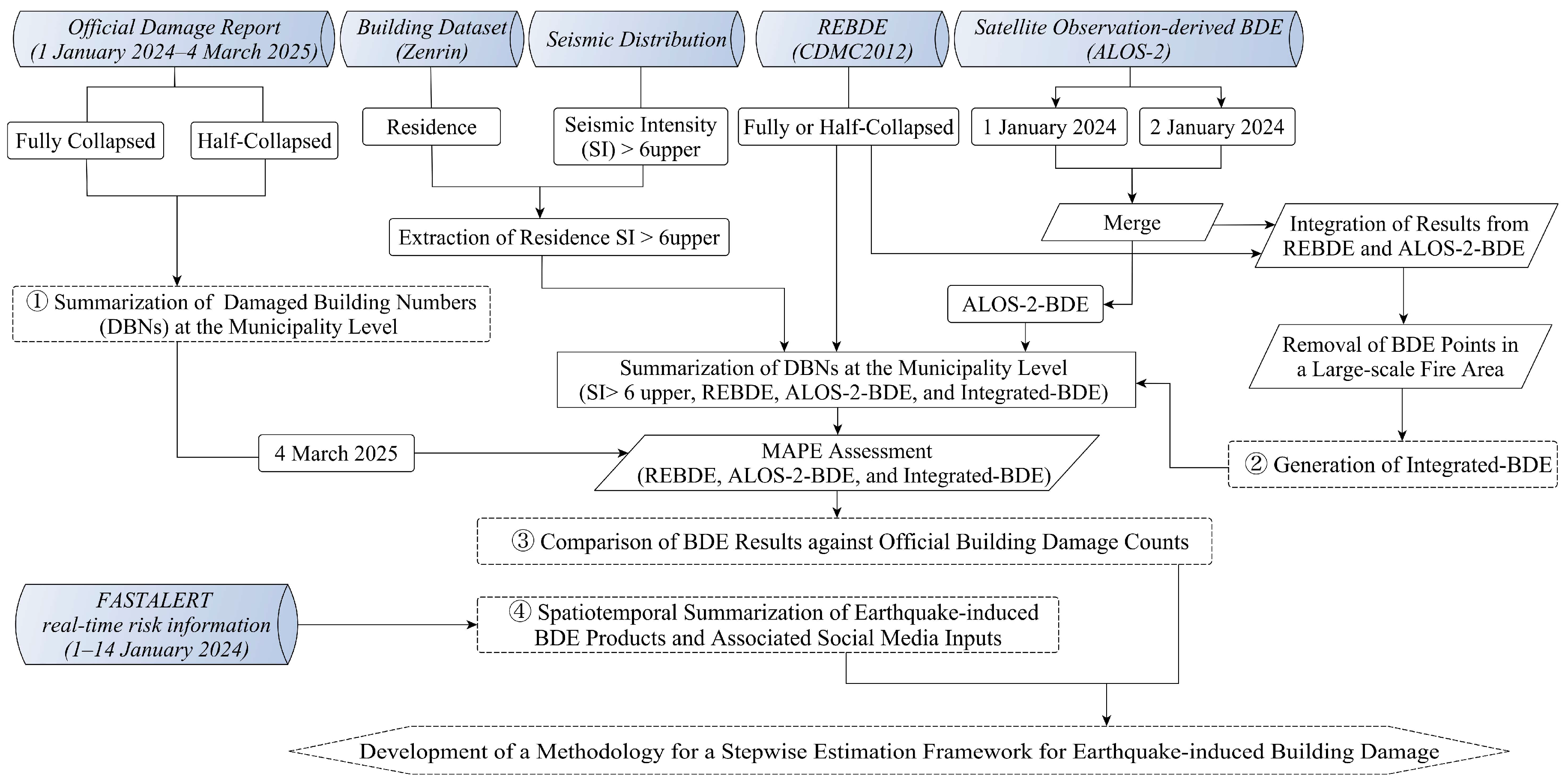
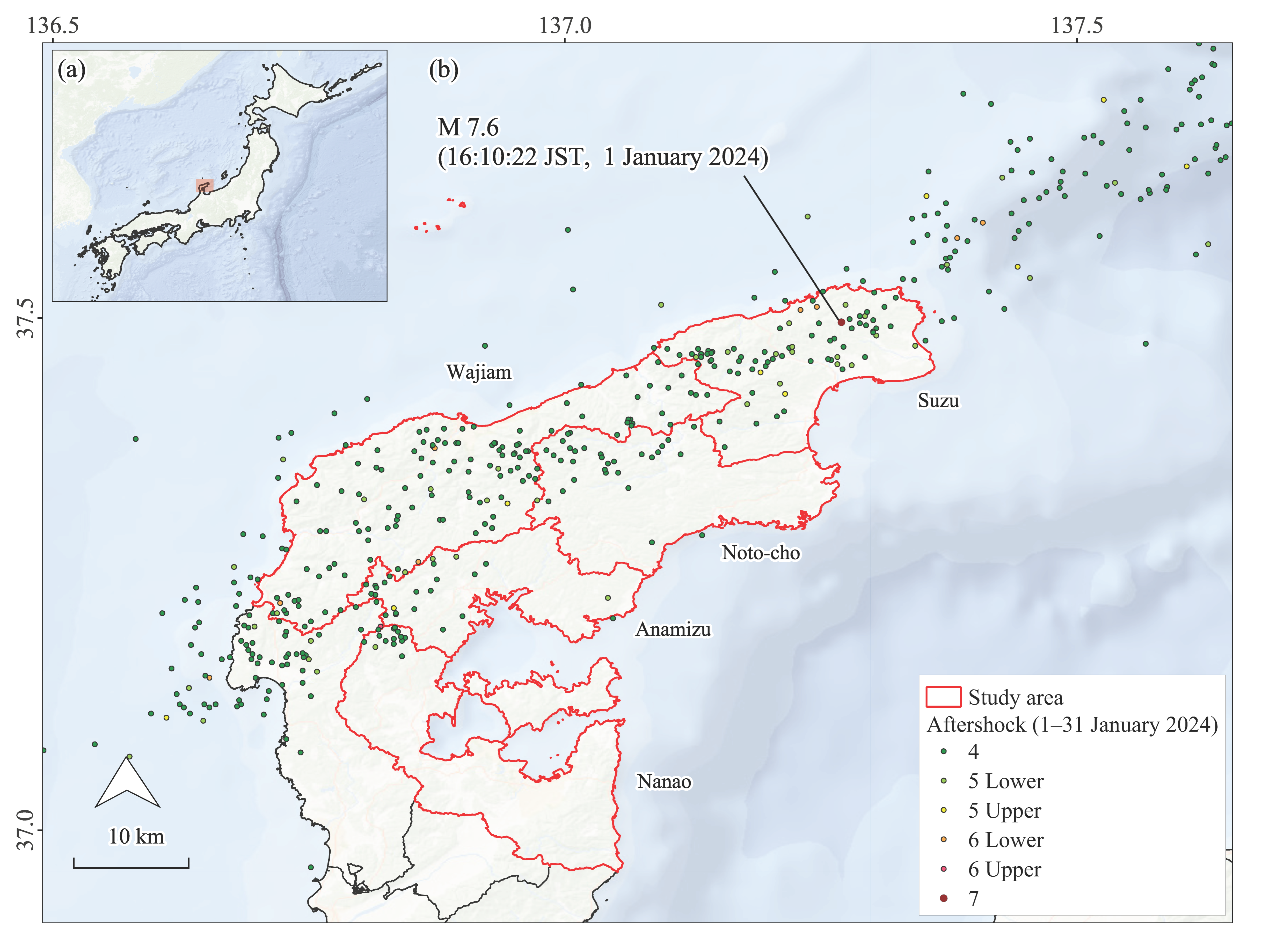

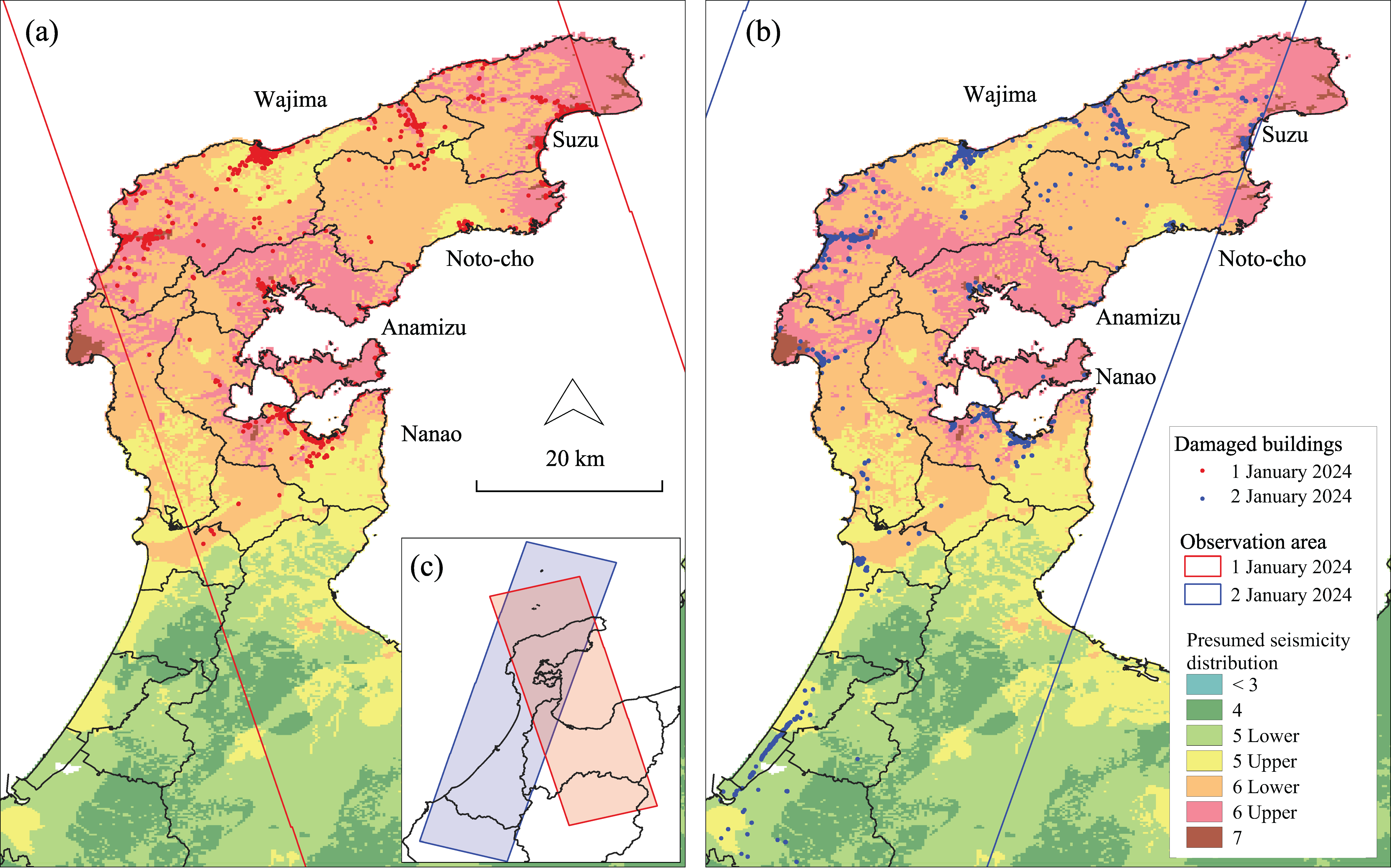


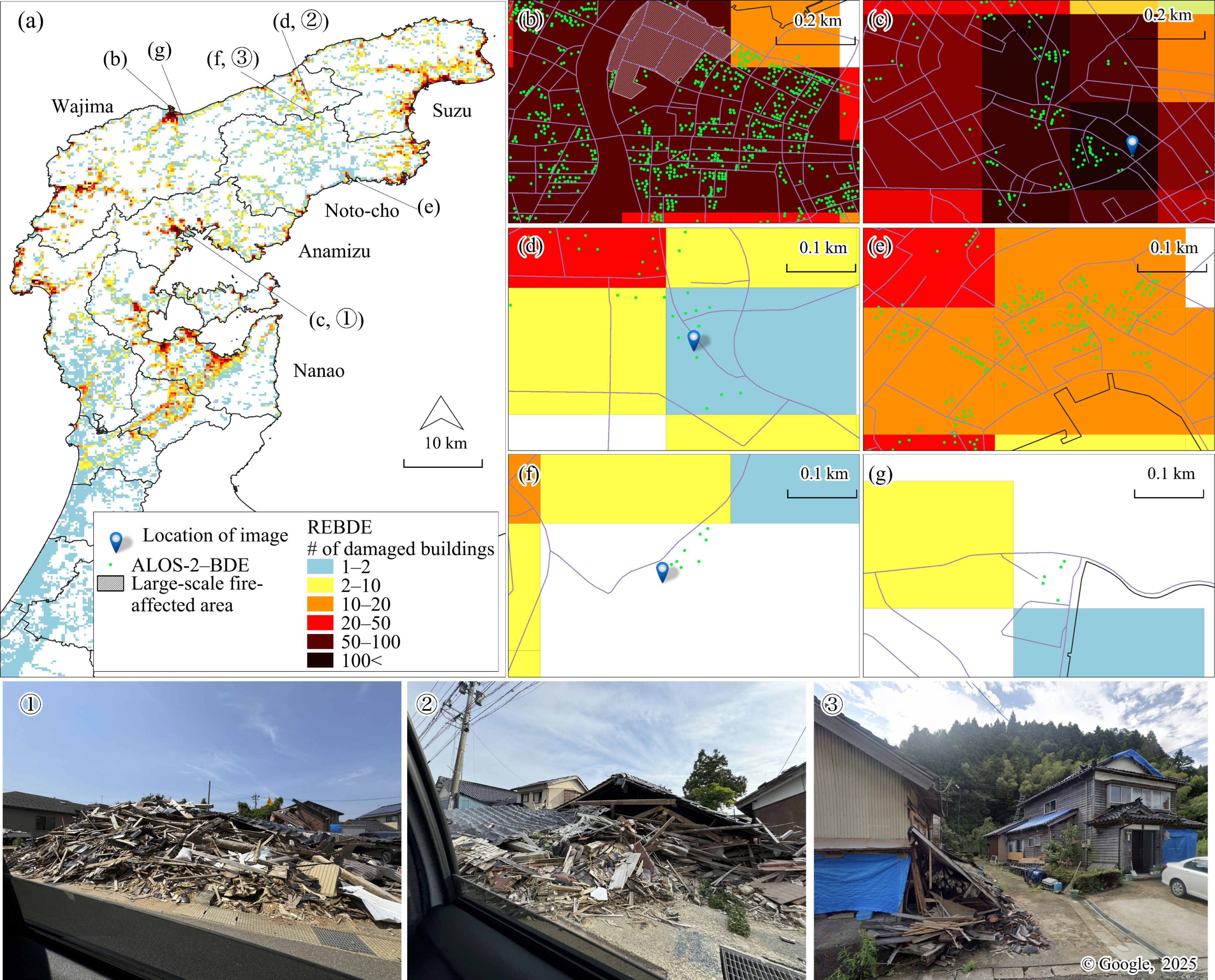
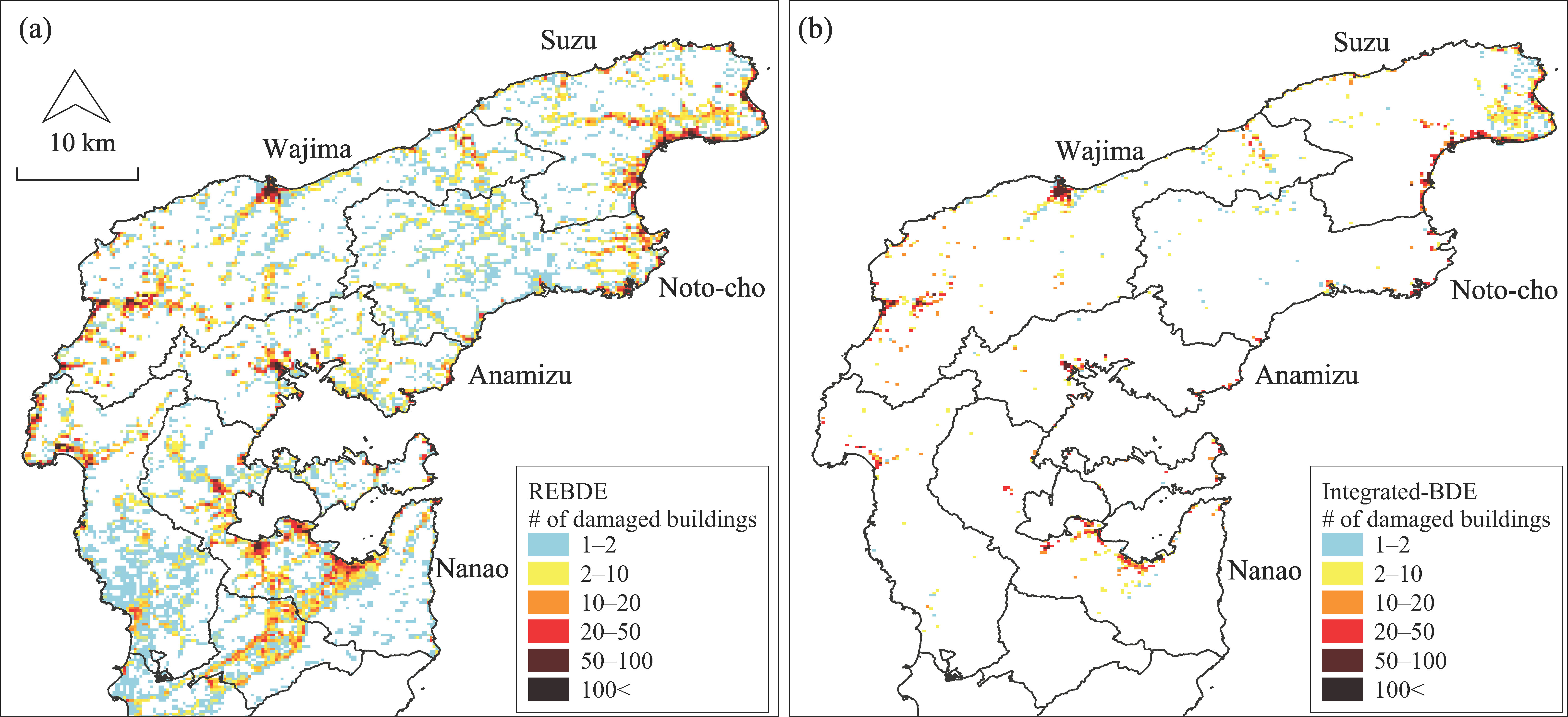
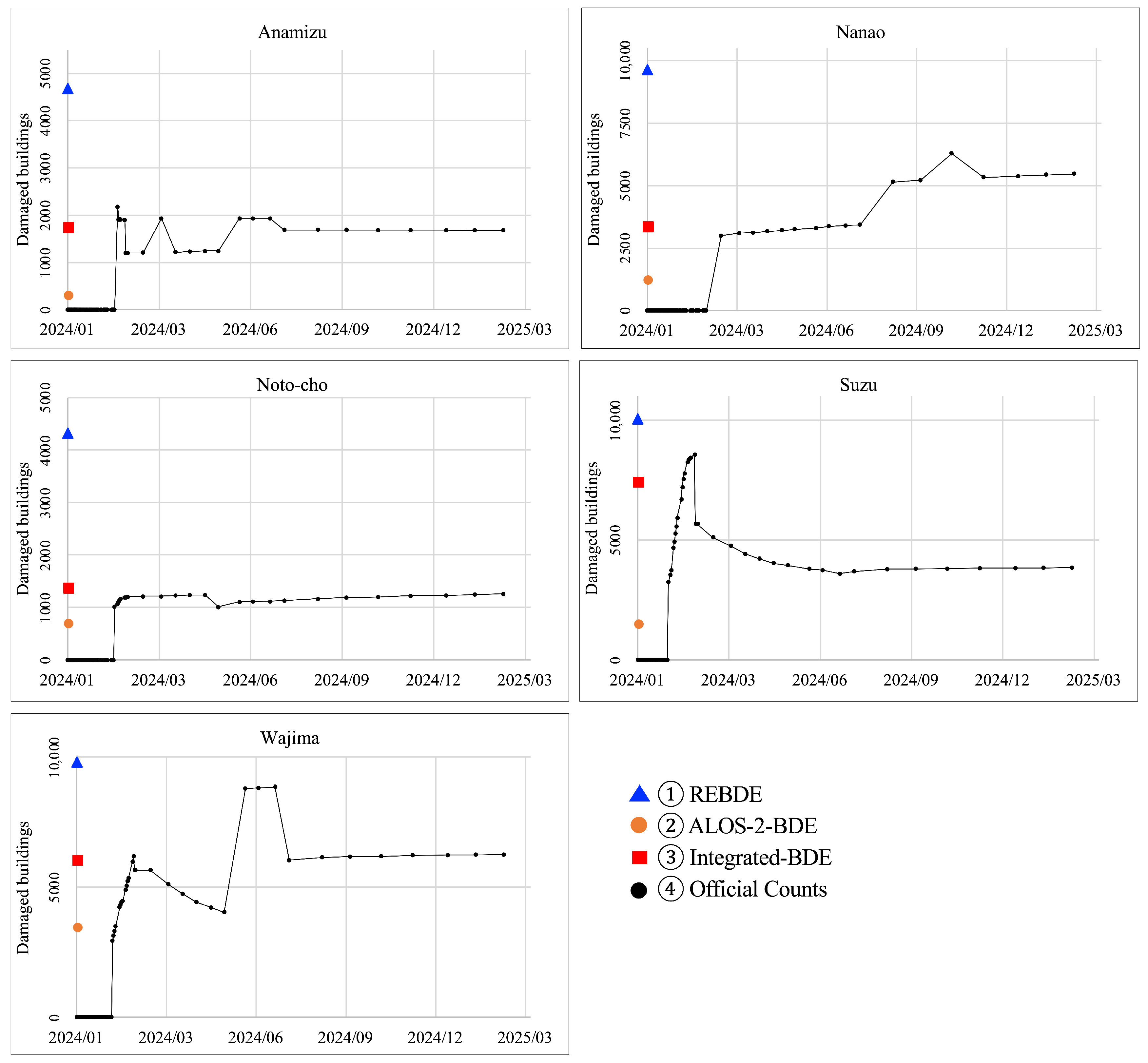
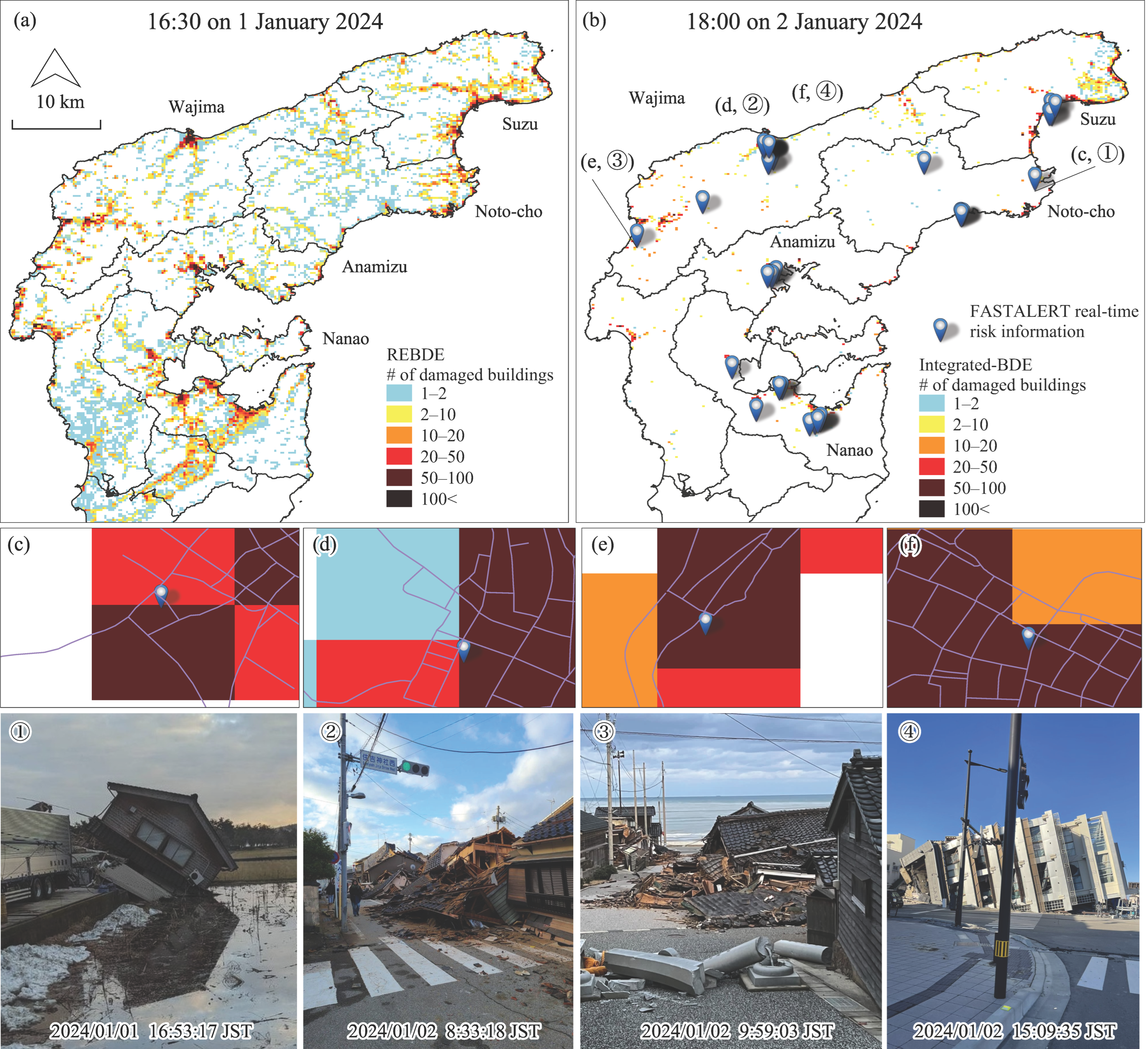
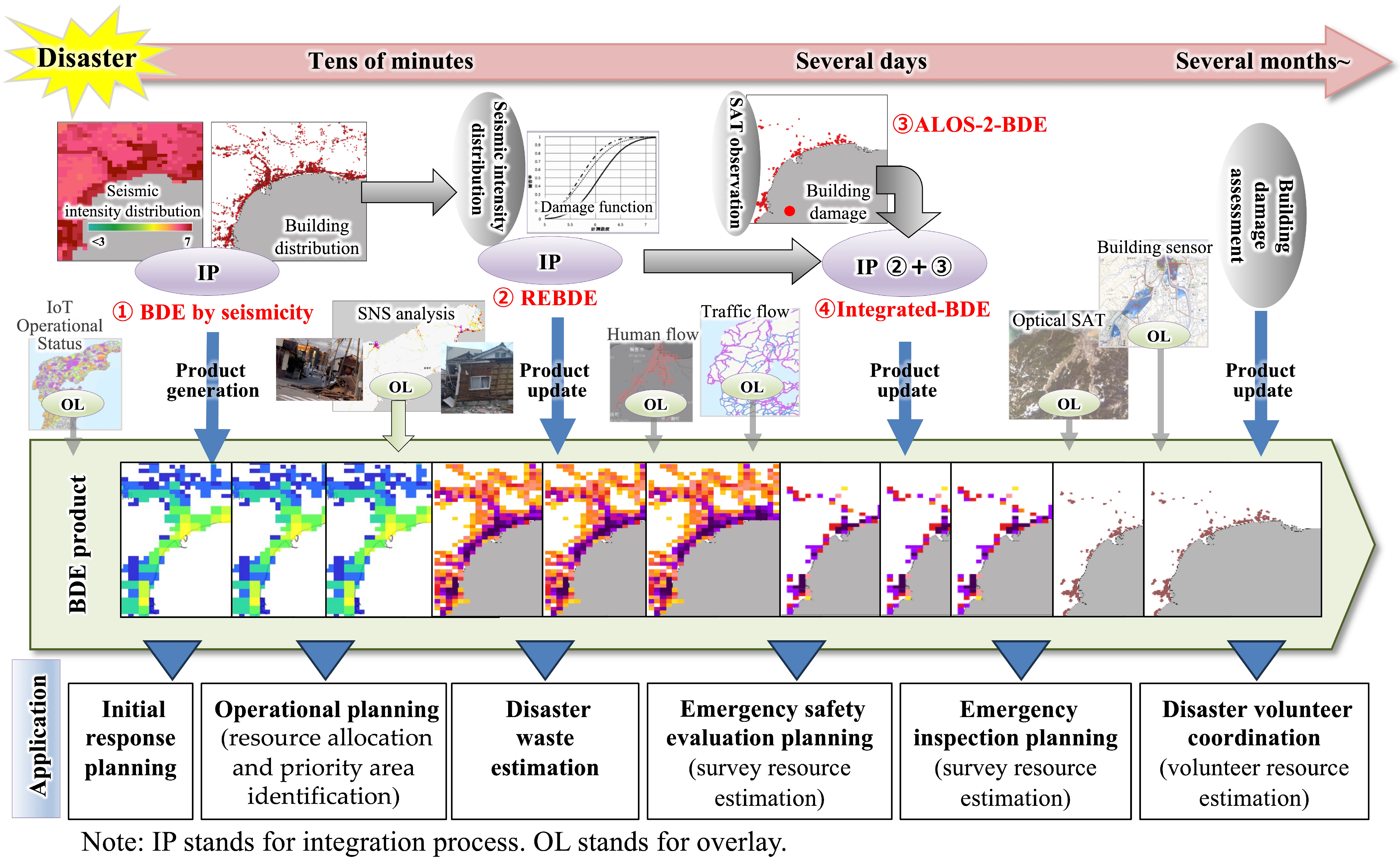
| Masonry Buildings | Reinforced Buildings | Classification of Damages |
|---|---|---|
 |  | Grade 1: Negligible to slight damage (no structural damage, slight non-structural damage) |
 |  | Grade 2: Moderate damage (slight structural damage, moderate non-structural damage) |
 |  | Grade 3: Substantial to heavy damage (moderate structural damage, heavy non-structural damage) |
 |  | Grade 4: Very heavy damage (heavy structural damage, very heavy non-structural damage) |
 |  | Grade 5: Destruction (very heavy structural damage) |
| Municipality | Human Casualties | Building Damage Level (Residential) | ||||||||
|---|---|---|---|---|---|---|---|---|---|---|
| Fatalities | Missing | Injured | Total | Full | Half | Partial | Total | |||
| Disaster-Related Death | Severe | Minor | ||||||||
| Nanao | 44 | 39 | 34 | 3 | 81 | 515 | 4951 | 11,262 | 16,728 | |
| Wajima | 196 | 95 | 2 | 213 | 303 | 714 | 2307 | 3951 | 4321 | 10,579 |
| Suzu | 157 | 60 | 47 | 202 | 406 | 1754 | 2089 | 1755 | 5598 | |
| Shika | 19 | 17 | 19 | 97 | 135 | 562 | 2470 | 4419 | 7451 | |
| Anamizu | 46 | 26 | 33 | 225 | 304 | 387 | 1289 | 1647 | 3323 | |
| Noto | 53 | 51 | 29 | 25 | 107 | 269 | 991 | 4505 | 5765 | |
| Total | 515 | 288 | 2 | 375 | 855 | 1747 | 5794 | 15,741 | 27,909 | 50,127 |
| Estimation Results/ Information/Data | Issued/Acquisition Date (dd/mm/yyyy) | Spatial Res. (m) | Method/Operational Mode (Polarization) | Agency |
|---|---|---|---|---|
| Presumed seismicity distribution | 1 January 2024 | 250 | – | NIED [3] |
| Real-time BDE | 1 January 2024 | 250 | CDMC 2012 Fully and half-collapsed | NIED [3] |
| ALOS-2-based BDE | 1 January 2024 2 January 2024 | – | Stripmap mode Horizontal–Horizontal polarization | JAXA [61] |
| Official damage report | 1 January 2024– 4 March 2025 | – | – | Ishikawa Prefectural Government [45] |
| Residence building data | 2023 | – | – | Zenrin [57] |
| FASTALERT real-time risk information in Japan | 1–14 January 2024 | – | – | JX-press Corporation [66] |
| 1 January 2024 | 2 January 2024 | 4 March 2025 | |||
|---|---|---|---|---|---|
| Seismic Intensity > 6 Upper | REBDE | ALOS-2-BDE | Integrated-BDE | Official Report | |
| Wajima | 5925 (–) | 9807 (–) | 3443 (–) | 6028 (–) | 6133 |
| Suzu | 7014 (–) | 10,064 (–) | 1481 * (–) | 7414 * (–) | 3744 |
| Nanao | 6344 (–) | 9660 (–) | 1215 (7) | 3348 (7) | 3469 |
| Anamizu | 3990 (–) | 4690 (–) | 301 (16) | 1731 (16) | 1686 |
| Noto-cho | 1749 (–) | 4324 (–) | 698 (–) | 1365 (–) | 1148 |
| Total | 25,022 (–) | 38,546 (–) | 7138 (23) | 19,886 (23) | 16,180 |
| MAPE (%) | 172.4 | 58.1 | 25.0 | – | |
| 1 January 2024 | 2 January 2024 | 3 January 2024 | Grand Total | |
|---|---|---|---|---|
| Anamizu | 3.8 | 3.8 | — | 7.7 |
| Nanao | 9.6 | 13.5 | 1.9 | 25.0 |
| Noto-cho | 3.8 | 9.6 | — | 13.5 |
| Suzu | 5.8 | 5.8 | — | 11.5 |
| Wajima | 30.8 | 9.6 | 1.9 | 42.3 |
| Grand Total (n = 52) | 53.8 | 42.3 | 3.8 | 100.0 |
| Earthquake Name | Scale (M) | Probability of Occurrence (30 Years>) | Seismic Intensity (SI) | Number of Affected Population | Deaths (Thousands) | Debris (Million Tons) | Damage (Trillion JPY) |
|---|---|---|---|---|---|---|---|
| Tokyo Metropolitan | 7.3 | 70% | 7 | 25.4M (SI 6L>) | 23 | 98 | 95 |
| Nankai Trough | 9.0 | 70–80% | 7 | 40.7M (SI 6L>) | 231 | 310 | 220 |
| Japan Trench/ Chishima Trench | 9.1/9.3 | 60% | 7 | Earthquake: 272 Municipalities Tsunami: 108 Municipalities | 199/100 | 110 | 48 |
Disclaimer/Publisher’s Note: The statements, opinions and data contained in all publications are solely those of the individual author(s) and contributor(s) and not of MDPI and/or the editor(s). MDPI and/or the editor(s) disclaim responsibility for any injury to people or property resulting from any ideas, methods, instructions or products referred to in the content. |
© 2025 by the authors. Licensee MDPI, Basel, Switzerland. This article is an open access article distributed under the terms and conditions of the Creative Commons Attribution (CC BY) license (https://creativecommons.org/licenses/by/4.0/).
Share and Cite
Kimijima, S.; Ping, C.; Fujita, S.; Hanashima, M.; Toride, S.; Taguchi, H. Stepwise Building Damage Estimation Through Time-Scaled Multi-Sensor Integration: A Case Study of the 2024 Noto Peninsula Earthquake. Remote Sens. 2025, 17, 2638. https://doi.org/10.3390/rs17152638
Kimijima S, Ping C, Fujita S, Hanashima M, Toride S, Taguchi H. Stepwise Building Damage Estimation Through Time-Scaled Multi-Sensor Integration: A Case Study of the 2024 Noto Peninsula Earthquake. Remote Sensing. 2025; 17(15):2638. https://doi.org/10.3390/rs17152638
Chicago/Turabian StyleKimijima, Satomi, Chun Ping, Shono Fujita, Makoto Hanashima, Shingo Toride, and Hitoshi Taguchi. 2025. "Stepwise Building Damage Estimation Through Time-Scaled Multi-Sensor Integration: A Case Study of the 2024 Noto Peninsula Earthquake" Remote Sensing 17, no. 15: 2638. https://doi.org/10.3390/rs17152638
APA StyleKimijima, S., Ping, C., Fujita, S., Hanashima, M., Toride, S., & Taguchi, H. (2025). Stepwise Building Damage Estimation Through Time-Scaled Multi-Sensor Integration: A Case Study of the 2024 Noto Peninsula Earthquake. Remote Sensing, 17(15), 2638. https://doi.org/10.3390/rs17152638







